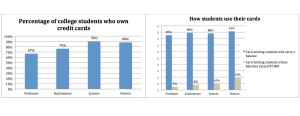Credit cards can jumpstart your credit score—if you know how to use them
After being nagged by his mother to start building his credit history, University of Kansas junior Chris Ouyang finally got a credit card for small purchases as his high-school years wound down—albeit one in his mother’s name. But several months ago, when Ouyang tried to apply for another credit card, he realized that, because his card was still tied to his mother’s account, his credit wasn’t as well-established as he’d expected it would be.
“I applied for about five different cards, and I got nothing back—they all said, ‘You have insufficient credit history,” Ouyang said. “I thought, ‘How could that be? I make $15,000 or $30,000 a year, and I spend money on that credit card I’ve had since high school.
Since then, Ouyang has been able to get a credit card in his own name through his mother’s credit-card company and to start reestablishing his credit history with it. He’s also stopped using the other card almost entirely because it doesn’t fit in with his credit-building plan.
“I wanted to make sure that, if I was trying to build credit, that was accomplishing that goal,” Ouyang said. “And you can see that it wasn’t doing that, because it was so hard to get any other credit card.”
Ouyang isn’t the only student who has made mistakes in his quest to build a credit history. Despite the increasing popularity of credit cards among college students, there are still many pitfalls awaiting students who want to use one to establish or polish their credit scores.
The idea of using credit cards to build a credit history has been gaining traction on campuses lately. Not only have the majority of students at all grade levels been using cards over the past few years (as shown in the chart below), but credit-card companies have also been showing up more often at universities to market their services as investments in students’ financial futures.
“A lot of universities are allowing credit-card companies to come on campus at new student orientations to help students open up cards,” said Brad Goldie, a finance professor at the KU School of Business. “It’s something that’s becoming very prevalent.”
Whether the students applying for these cards are responsible or knowledgeable enough to use them correctly is a different matter. Karolyn Stattelman, the manager of Jayhawk Federal Credit Union, said credit cards are riskier for students than other types of loans because it’s easy to miss payments and difficult to get advice on how to use the card in a way that builds credit rather than harms it.
“Credit-card companies aren’t going to counsel a student like a bank or credit union can,” Stattelman said.
For many students, Brad Goldie said, the biggest problem for students trying to use a credit card responsibly is overspending.
“While it’s a good idea to have good credit and to build good credit, at the end of the day, the credit-card companies are in this to make money,” Goldie said. “[Students] often assume that there’ll be enough money next month to pay the bill; they don’t pay enough attention to how much they’ve charged.”
So how can students use these cards responsibly? According to Goldie, the trick to building a great credit score on a card is charging conservatively and not trying too hard to impress the credit-reporting agencies.
“If you’re just getting started, get something with a small credit limit, where even if you max it out you’ll be able to pay it off, and only use it for the essentials that you would otherwise purchase,” Goldie said. “Charging more on the card each month isn’t necessarily going to result in a better credit score.”
For the most part, Chris Ouyang sticks to this type of plan, only buying groceries and the occasional textbook on credit. However, when he’s certain he can pay the bills, he won’t hesitate to put a little more on his card, as he did recently when traveling for a mock trial competition.
“When we got [to the competition], we needed a hotel, so I put my own credit card on file and I paid it,” Ouyang said. “Eventually, Student Senate reimbursed me, so it worked out fine.”
Even though he was sure he could pay it back, Ouyang said that he’s convinced this will better prove his responsibility to people analyzing his credit.
“It shows your ability to pay back large purchases on your credit history, so I really benefitted,” Ouyang said.
Students’ credit habits
Surprisingly enough, many college students are using their cards fairly responsibly. According to data from education loan provider Sallie Mae, students who have credit cards overwhelmingly elect to keep a small balance on their cards, and fewer than one-fifth of students in all grade levels are running balances of more than $7,000.
Source: Sallie Mae
